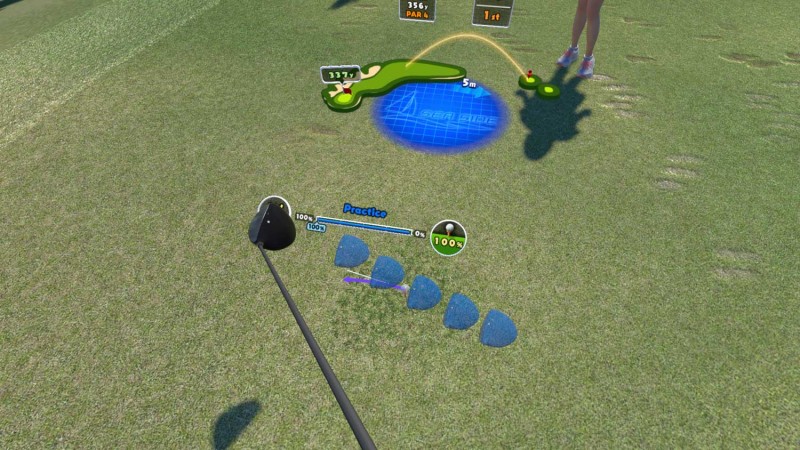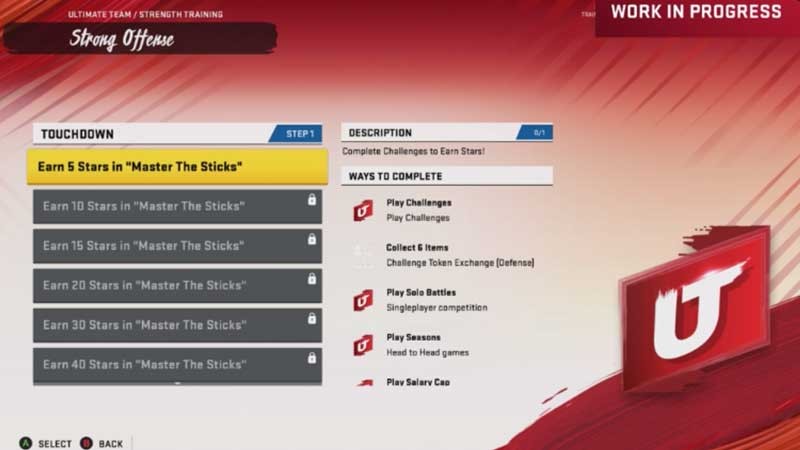A couple weeks ago in the Sports Desk I covered a smattering of golf titles, making passing mention of Everybody’s Golf VR. I recently got my hands on the PlayStation VR game and came away satisfied with the VR experience as well as the overall Everybody’s Golf vibe.
First and foremost, Everybody’s Golf VR provides good swing fidelity, starting by accurately reading your club in the environment when you step up to the ball. Take a few practice swings to see how your club face is meeting the ball (and therefore influencing the ball’s general direction after contact) and the percentage power generated by your swing before letting it rip.

The overall course graphic overlay is nice, and the blue club trail tells you your practice swing is making contact. A red trail means you probably have to take a step forward or back to address the ball.
In real life I don’t have a particular golf swing per se I adhere to, but since the Move controller registers your swing by whether the club face strikes the ball flush or at an angle (thereby producing slice or fade) as well as the velocity of your swing, I could produce good results both by using either a truncated swing or a full motion as if I was really golfing.
Either way it doesn’t take long to get used to, and I can anticipate results on tee and fairway shots. When you’re in rough or angled terrain things get trickier of course because of the lie of the ball (as well as using irons), but even hitting these becomes less stressful.
Believe it or not, you’ll get better results than this. Probably.
Charles Barkley with tracer is everything we wanted and more. pic.twitter.com/zCFdgHRFGO
— Skratch (@Skratch) May 6, 2019

Caddy events like this one play up VR’s immersive environment similar to a 3D movie.
The look and whimsical nature of the Everybody’s Golf series translate nicely to the VR format, and although graphical crispness is lost the further you look down the fairway, the series’ classic topography matrix for the green, showing its undulations, makes your short game one of the more fun parts of Everybody’s Golf VR.
Caddies also are an important part of the experience, not only with the chirps of advice they give, but through special events that pop up the better you do. I’ve seen a few of these, and although they are mere diversions, it’s fun how they make use of VR’s 3D environment.
Despite the title’s positives, its shortcomings are also apparent. It only has three courses and a practice area, and the progression system is stingy perhaps because there’s simply not a lot of content (FYI it’s $29.99). There are 10 levels of achievement to earn, and through them you’ll unlock the different courses, caddies, and even things as minute as opening up the replay gallery.
Perhaps part of the reason for the game’s shallow progression is the inevitable fact that the series’ usual character customization through outfits doesn’t come into play since it’s a VR title and you don’t see your avatar in the first place.
Everybody’s Golf VR is a fun representation of the series in the VR space. I certainly wish it was a full-fledged title, but it’s still an enjoyable day out on the course.
MADDEN 20’S ULTIMATE TEAM OVERHAUL

The recent Madden 20 livestream, blog, and Gridiron Notes from developer EA Tiburon focus on Ultimate Team, which is reorganizing itself even if the basics of card collection and coins are the same.
- New this year are Missions, which is a way the mode guides you towards items and rewards (based on your MUT level) encompassing different play experiences within MUT as a whole. The example EA Tiburon gives is a mission could be “Earn 50 Series Trophies,” which would then point you towards the areas where you could earn those trophies such as Squad Seasons, challenges, Solo Battles, etc.
- Solo Challenges are now called Ultimate Challenges because most are no longer strictly solo affairs. You can complete them by yourself or you can bring on a friend. If you do, like in squad play your rosters will be merged.
- Ultimate Challenges dole out increasing milestone rewards based on how many stars you’ve earned playing the challenges in that category. You choose the difficulty of each challenge (1, 2, or 3 stars), and can achieve bonus goals that could bump your total to five stars. Unlike previous years, you can re-try bonus goals even if you’re already finished the main challenge. Likewise, if you beat the one-star version of a challenge, for instance, you can always go back and try it on the three-star difficulty.
- In perhaps one of the biggest little details in MUT in Madden 20, players can advance from one challenge to another in the same sequence without having to back out to the main challenge menu.
-
Superstar abilities and X-Factors are included in Ultimate Team, and these mainly take over for red chems. These special abilities can be equipped on all the players in your lineup, but you can only pick three offensive and three defensive players to make active at one time.
- The Superstar abilities and X-Factors you apply to player items conform to preset archetypes for that player. Thus, abilities that can be applied to a Tom Brady card, for example, are centered around the Field General archetype, and not those for a running/scrambling QB.
- Players’ OVR rating are designed specifically around the archetypes instead of a single OVR formula applied to each position.
- Players can see the median value of an item in the auction house.
- House rules are coming back, and the studio says it wants to offer them closer to launch than last year. EA Tiburon also wants to make them more condensed such as dropping you into the start of overtime using college rules.
THE TICKER
NCAA Investigating Ways To Compensate Athletes For Names & Likenesses
Dirt Rally 2.0’s New Season of Content Comes Out On June 4
MLB the Show 19 Diamond Dynasty Third Inning Program Details
